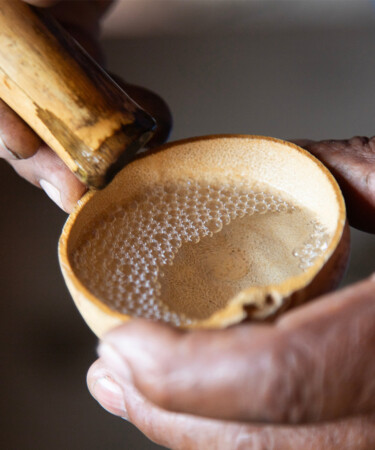A traditional spirit of Mexico, mezcal is known for its centuries of rich history and distinct set of artisanal techniques that have been passed down for generations. But recently, the once-local spirit has seen an astronomic boom in popularity in the U.S., going from a niche pursuit to a widely used cocktail ingredient. The spirit even found its way into beloved modern classics like the Naked and Famous, Division Bell, and Oaxaca Old Fashioned.
Though mezcal’s newfound fame is great for fans of the spirit, the increased demand has led to a dramatic change in the scale of production. And as mezcal brands continue to ramp up in size and industrialize the process, the region is losing some of the spirit’s enduring traditions. One of the techniques that few producers still hold onto is a method called “reading the pearls,” which is used to determine the spirit’s ABV.
In this process, the producer collects some of the liquid with a large, straw-like tool and splashes it into a bowl. The motion of the mezcal hitting the container causes it to form bubbles — referred to as the “pearls” in this context. By observing the size and longevity of the bubbles, the producer can determine the alcohol content of the spirit. The ability to translate this information into a precise ABV is a skill passed on from generation to generation of artisanal mezcal makers.
Though there is a lot of nuance to this expertise, the basic principle is that if the mezcal is too low or high in alcohol, the bubbles burst rapidly. Only when the spirit is in the sweet spot of around 50 percent ABV are the bubbles stable for a longer period of time.
Now that technology exists to determine the precise alcohol content of a liquid, one might wonder if this historic practice is actually an accurate form of measurement. A 2020 study published in Scientific Reports put this question to the test. The team, led by Dr. Roberto Zenit, a professor who conducts research in fluid mechanics, examined mezcal samples with different alcohol contents — adding water to some and adding ethyl alcohol to others to control the ABV in each. They systematically irritated the samples, splashing them into a container as in traditional production, leading to the formation of surface bubbles. The scientists quantitatively measured the size and longevity of the pearls.
The series of tests revealed that the time-honored process of “reading the pearls” does actually work, with the lifespan of the bubbles reaching a peak around the 50 percent ABV mark. The study concluded that the formation and bursting of the bubbles could be attributed to the surface tension, density, and viscosity of the liquid. The researchers also suggested that these findings might provide insights into other natural occurrences of bubbles and foams, such as volcanic flows.
While producers generally send their mezcal off for laboratory testing to determine the ABV percentage today, reading the pearls is an important part of mezcal’s heritage and a tradition we hope to continue to see from artisanal producers.
